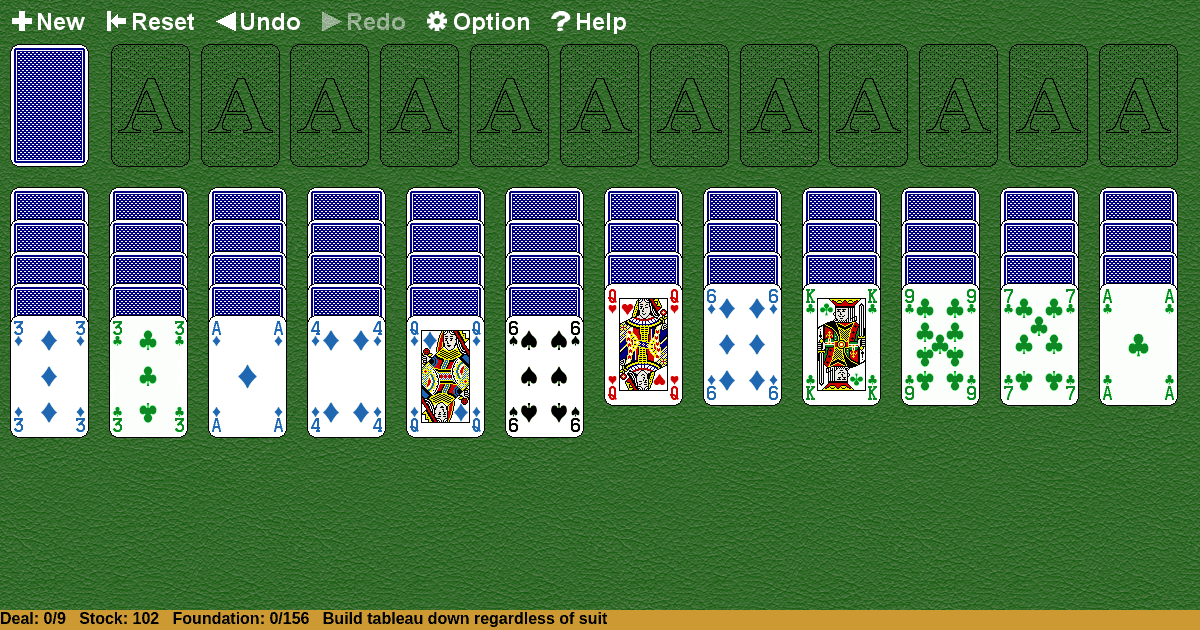Spider Three Deck
Home |
How to play |
FAQ |
About
How to play Spider Three Deck?
Game Objective:
The primary goal in Spider Three Deck Solitaire is to assemble complete descending sequences of 13 cards, from King down to Ace, all of the same suit, within the tableau columns. Once a full sequence is completed, it is removed from play. The game is won when all cards have been organized into these complete sequences and removed from the tableau.
Setup & Layout:
Deck Composition:
Use three standard 52-card decks, totaling 156 cards.Tableau:
The tableau consists of a set number of columns (typically 13, corresponding to the number of cards in a suit per deck).
Each column is dealt cards in descending order:The precise initial deal may vary by platform, but a common setup is to deal a fixed number of cards to each tableau column, with only the top card of each column face-up and the rest face-down.
Stock:
The remaining cards after the tableau is dealt form the stock pile. These are used to deal additional cards to the tableau during gameplay.Face-Up and Face-Down Cards:
Only the top card of each tableau column is dealt face-up.
All other cards in the tableau columns are dealt face-down.
Key Play Areas Defined:
Tableau: Main play area where sequences are built.
Stock: Pile of undealt cards used to introduce new cards into play.
Foundations: Not present as separate piles; completed sequences are removed from the tableau instead.
Spider Three Deck Solitaire Rules:
Card Movement Principles:
Cards in the tableau are built in descending order (King, Queen, Jack, … down to Ace).
Groups of cards in descending sequence of the same suit may be moved together from one tableau column to another.
Only cards of the same suit may be moved as a group; otherwise, only the top card may be moved individually.
Building Sequences:
Sequences must be built down in rank and by suit.
A sequence can only be moved if all cards in the sequence are of the same suit and in descending order.
Moving Cards/Sequences:
You may move a single card or a group of cards (all of the same suit and in descending order) from one tableau column to another.
Cards or sequences can only be placed onto a tableau column if the top card of the destination column is one rank higher than the bottom card of the moving sequence and is of the same suit.
Completing Sequences:
When a complete sequence from King down to Ace of the same suit is formed within a tableau column, it is immediately removed from play.
Gameplay:
Player Actions:
Move cards or valid sequences between tableau columns according to the rules.
Reveal face-down cards by clearing face-up cards above them.
When no more moves are possible or desired, deal additional cards from the stock pile.
Dealing New Cards:
When the player chooses to deal from the stock, one card is added face-up to each tableau column.
You cannot deal new cards from the stock if any tableau column is empty; all columns must contain at least one card before dealing.
No More Legal Moves:
If no moves are possible and the stock is depleted, the game ends in a loss.
If moves are available, play continues.
Winning & Losing Conditions:
Winning:
The game is won when all cards have been removed from the tableau by forming and removing complete descending sequences of the same suit (King to Ace) for all suits in all three decks.
Losing/Unwinnable State:
The game is lost if no legal moves remain and the stock is exhausted.
The game is also unwinnable if it becomes impossible to complete all required sequences due to blocked cards or unsolvable arrangements.
Special Rules & Edge Cases:
Filling Empty Spaces:
If a tableau column becomes empty, it may only be filled according to specific rules:
- Typically, only a King or a valid descending sequence starting with a King may be placed in an empty column.
- Some implementations may allow any valid sequence to fill an empty column; always verify with the specific platform's rules.
Restrictions:
You cannot deal new cards from the stock if any tableau column is empty.
Only sequences of the same suit and in perfect descending order may be moved as a group.
Exceptions:
If a sequence is not of the same suit, only the top card may be moved.
If the stock is depleted and moves remain, play continues until no moves are possible.
Edge Case:
If the final deal from the stock cannot be distributed evenly (e.g., fewer cards than columns), only the available cards are dealt, typically to the leftmost columns.
Note:
Spider Three Deck Solitaire is a rare and challenging variant. Always refer to the specific platform's rules for minor implementation differences, but the above guide covers the core, universally accepted mechanics for this variant.




























































